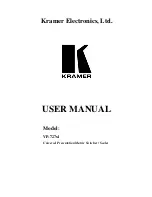
Section 6: Instrument programming
Models 707B and 708B Switching Matrix Reference Manual
6-32
707B-901-01 Rev. A / August 2010
String library functions
Function Description
string.byte(s)
string.byte(s, i)
string.byte(s , i ,j)
Returns the internal numeric codes of the characters
s[i],
s[i+1], ···, s[j]
. The default value for
i
is
1
; the default
value for
j
is
i
.
Note that numeric codes are not necessarily portable across
platforms.
string.char(···)
Receives zero or more integers. Returns a string with length equal
to the number of arguments, in which each character has the
internal numeric code equal to its corresponding argument.
Note that numeric codes are not necessarily portable across
platforms.
string.format(formatstring,
···)
Returns a formatted version of its variable number of arguments
following the description given in its first argument, which must be a
string. The format string follows the same rules as the
printf
family of standard C functions. The only differences are that the
modifiers
*
,
l
,
L
,
n
,
p
, and
h
are not supported and there is an extra
option,
q
. The
q
option formats a string in a form suitable to be
safely read back by the Lua interpreter: the string is written between
double quotes, and all double quotes, newlines, embedded zeros,
and backslashes in the string are correctly escaped when written.
For instance, the call:
string.format('%q', 'a string with "quotes" and
\n new line')
will produce the string:
"a string with \"quotes\" and \
new line"
The options
c
,
d
,
E
,
e
,
f
,
g
,
G
,
i
,
o
,
u
,
X
, and x all expect a number
as argument.
q
and
s
expect a string.
This function does not accept string values containing embedded
zeros, except as arguments to the
q
option.
string.len(s)
Receives a string and returns its length. The empty string
""
has
length
0
. Embedded zeros are counted, so
"a\000bc\000"
has
length
5
.
string.lower(s)
Receives a string and returns a copy of this string with all uppercase
letters changed to lowercase. All other characters are left
unchanged. The definition of what an uppercase letter is depends
on the current locale.
string.rep(s, n)
Returns a string that is the concatenation of
n
copies of the string
s
.
string.sub(s, i)
string.sub(s, i ,j)
Returns the substring of
s
that starts at
i
and continues until
j
;
i
and
j
can be negative. If
j
is absent, it is assumed to be equal to
-
1
(which is the same as the string length). In particular, the call
string.sub(s, 1, j)
returns a prefix of
s
with length
j
, and
string.sub(s, -i)
returns a suffix of
s
with length
i
.
string.upper(s)
Receives a string and returns a copy of this string with all lowercase
letters changed to uppercase. All other characters are left
unchanged. The definition of what a lowercase letter is depends on
the current locale.
















































